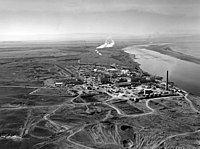
Photo from wikipedia
Beneficial use of dredged sediments, either in harbours or waterways, is based on their potential as alternative resources. Such sediments can be considered as bulk materials for industrial needs, which… Click to show full abstract
Beneficial use of dredged sediments, either in harbours or waterways, is based on their potential as alternative resources. Such sediments can be considered as bulk materials for industrial needs, which is predicated on their current waste status or meeting end-of-waste constraints. They also can be an integral part of beneficial use projects using sediments as a bulk component, including civil engineering and landscaping. This is particularly important for beneficial use projects focusing on climate change effects mitigation, such as flood protection works, coastline defence or littoral urban areas redevelopment. When dredged sediment is used as a bulk material, its acceptability is based on an assumed homogeneity of its properties. On-site analyses allow pre-dredging detailed mapping at a denser scale than laboratory ones; monitoring dredgings during operations and during processing; and continuous control of their properties at the implementation site. This is currently possible only for a selection of inorganic analytes. When dredgings are part of a larger beneficial use project, on-site analyses facilitate first the baseline survey and the sediment source characterisation. Continuous monitoring of the sediment load allows a fast detection of contamination hot spots and their adequate management. Site survey via on-site instruments allow end users and communities to check themselves the contamination level, hence acceptability is better. On-site dredged sediment analyses monitor both building properties and environmental compliance; soil and sediment analyses at receiving sites; surface and groundwater, either for impact assessment or for monitoring works. On-site instruments provide immediate results and allow dynamic or adaptive sampling strategies, as well as allowing operational decisions in real time. Confirmation by laboratory analyses is required for validation, but on-site sample screening for laboratory analyses improves their efficiency. The present paper was developed on the basis of an earlier presentation, which it developed and updated extensively.
Journal Title: Land
Year Published: 2022
Link to full text (if available)
Share on Social Media: Sign Up to like & get
recommendations!